1lumen selects and reviews products personally. We may earn affiliate commissions through our links, which help support our testing.
Convoy S21E review: EDC flashlight test
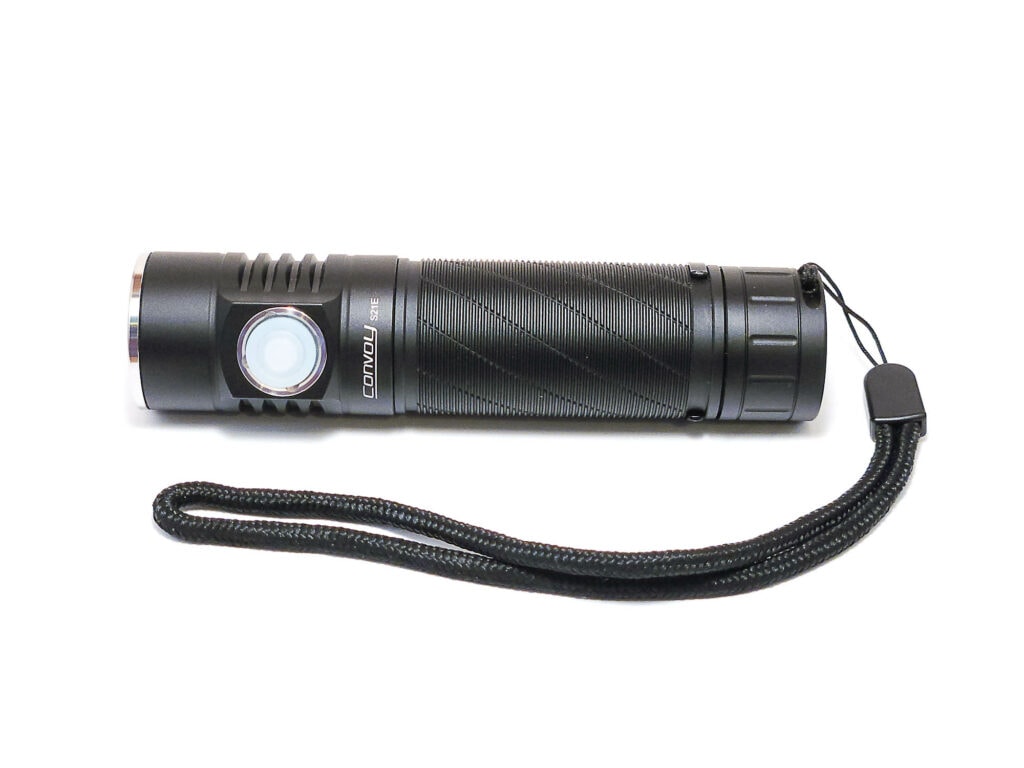
Convoy S21E specifications
| Brand & Model | Convoy S21E |
|---|---|
| LED | Nichia 519a 3000K as tested |
| Lumens | 1300 Lm |
| Beam intensity | – |
| Battery config. | 1*21700 |
| Onboard charging | USB-C |
| Modes | 4 stepped or smooth ramping |
| Blinkies | Strobe |
| Reflector | Orange peel |
| Waterproof | IPX4 |
| Review publication date | September 2022 |
Introduction:
Convoy, long known for being a DIY-friendly budget brand, brings forth a new entry in their 21700-sized lineup: The S21E. This pocket sized light differs from most Convoys in three ways: Side switch, e-switch driver and UI, and integrated charging. How do these features set the S21E apart from other Convoys? Read on to find out.
Package quality.
If you’ve ever bought a Convoy, you know what you’re getting here: A plain white box with a sticker on it. That’s the extent of Convoy packaging. It’s a familiarity to collectors, but to someone used to more marketing on their packaging, it can be pretty stark.
The total contents of the white Convoy box include:
- Convoy S21E with clip attached, in a bubble wrap sheath
- Lanyard
If you need instructions on how to use the S21E, you’ll need to reference the UI section below.
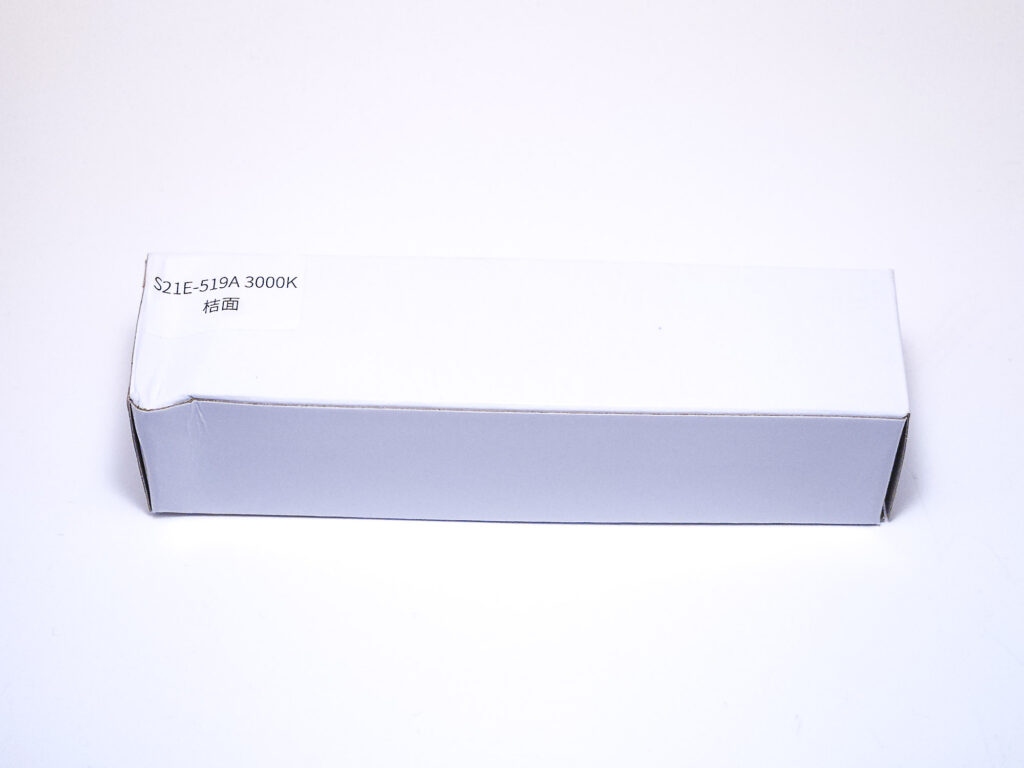
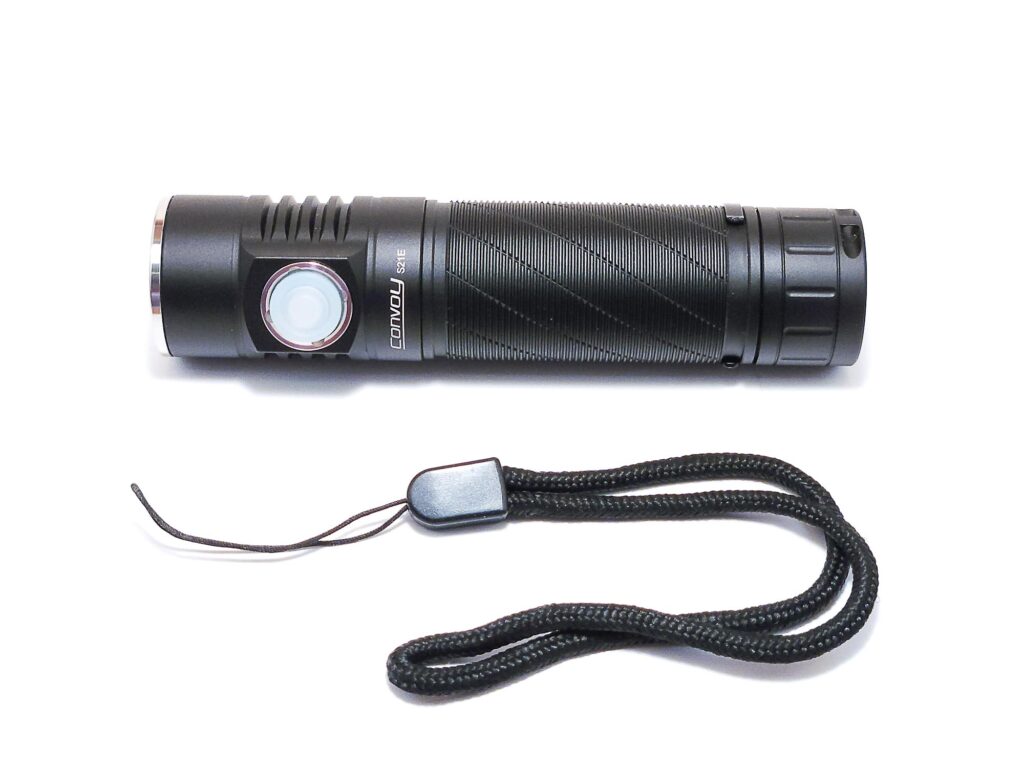
Flashlight in use
Like most of Convoy’s S-line of flashlights, the S21E is general purpose. In fact, the side switch and onboard charging would make it even more accessible, but more on that later. Despite using a 21700 battery, it’s actually pretty pocketable. The 21700 does make it heavier, but if weight isn’t a concern, then it’ll fit the bill.
The S21E comes with a bi-directional friction clip, but this is the standard Convoy S21-sized clip and the loops on the ends are really too small. Even though it’s relatively deep carry, it’s very hard to slide the clip all the way on over a pants pocket; it just doesn’t really fit, so you end up with even more of the tail cap sticking out of your pocket. This is the only clip you can use, since Convoy’s screw-in clip won’t work for this light. There’s a basic lanyard, too, if you’re interested in that.
The light is pretty good at staying put. The button and charging port opposite it jut out from the side of the head, which will prevent it from rolling, and the tail cap is flat, allowing for it to tail stand, although the tail cap does not have a magnet in it.
The button for the electronic side switch is very pronounced, though with many lights with integrated charging, the charging port is directly opposite the switch, so it’s easy to confuse the two. To avoid that, I always like to keep the clip on the other side from the switch. The switch has a translucent boot and it would be nice if it included a status or battery level indicator other than while charging.
Both ends have springs, so the S21E can accept batteries of different sizes. Because of that, my battery does rattle against the wall of the tube, but it has not disconnected at all.
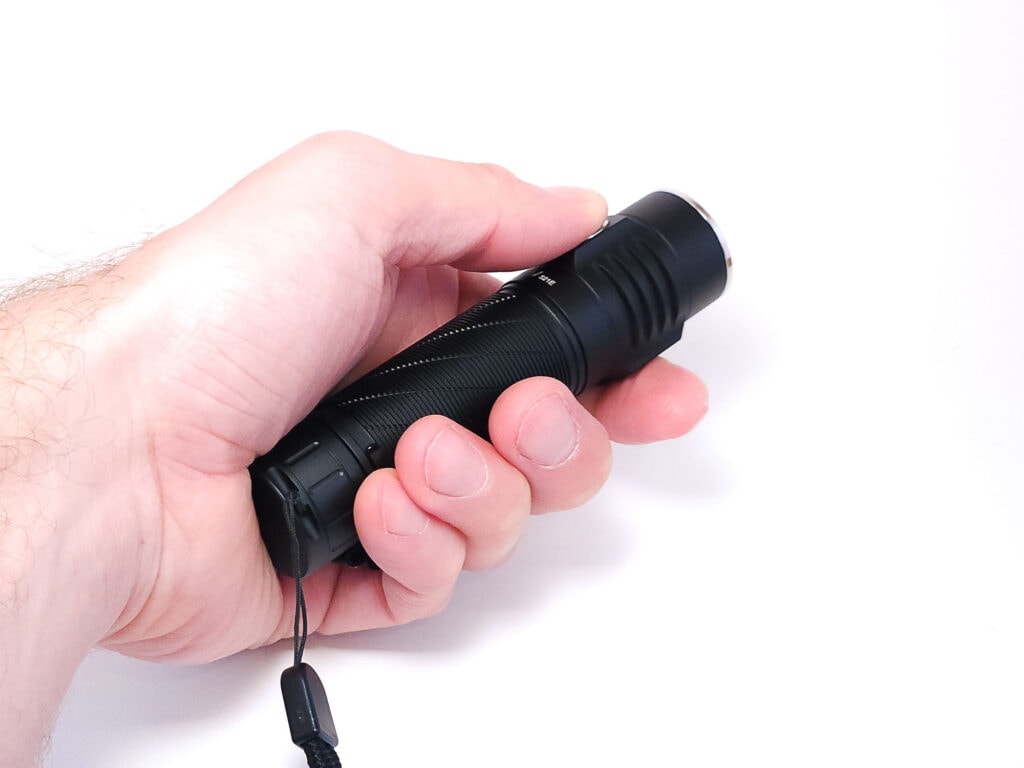
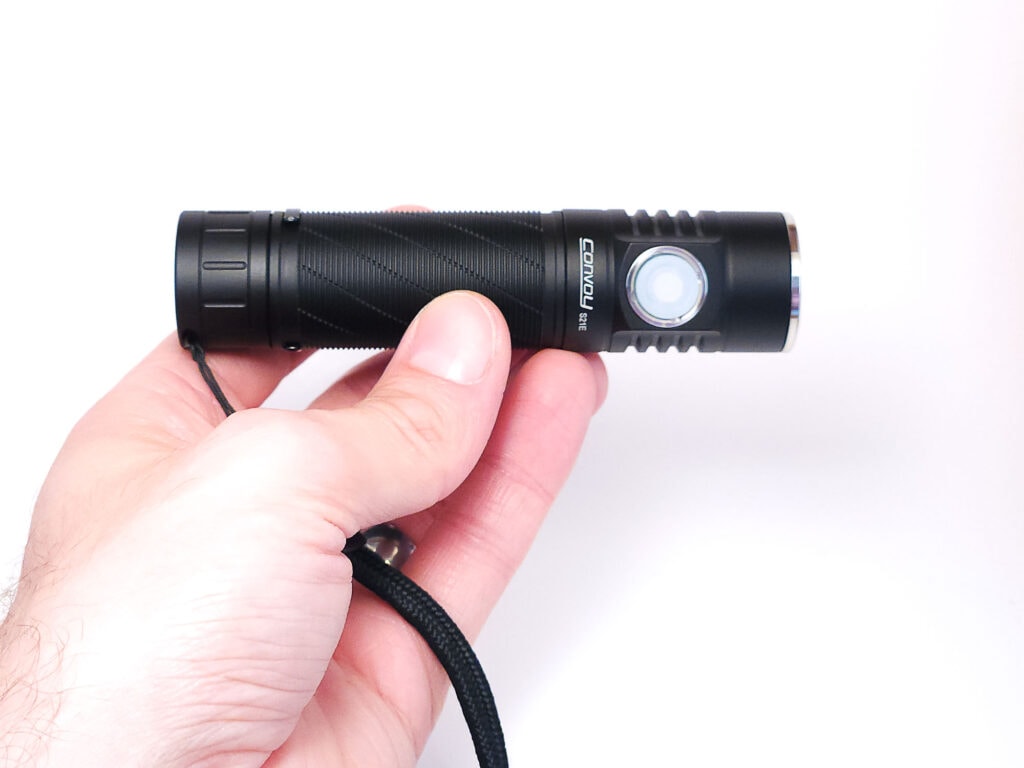
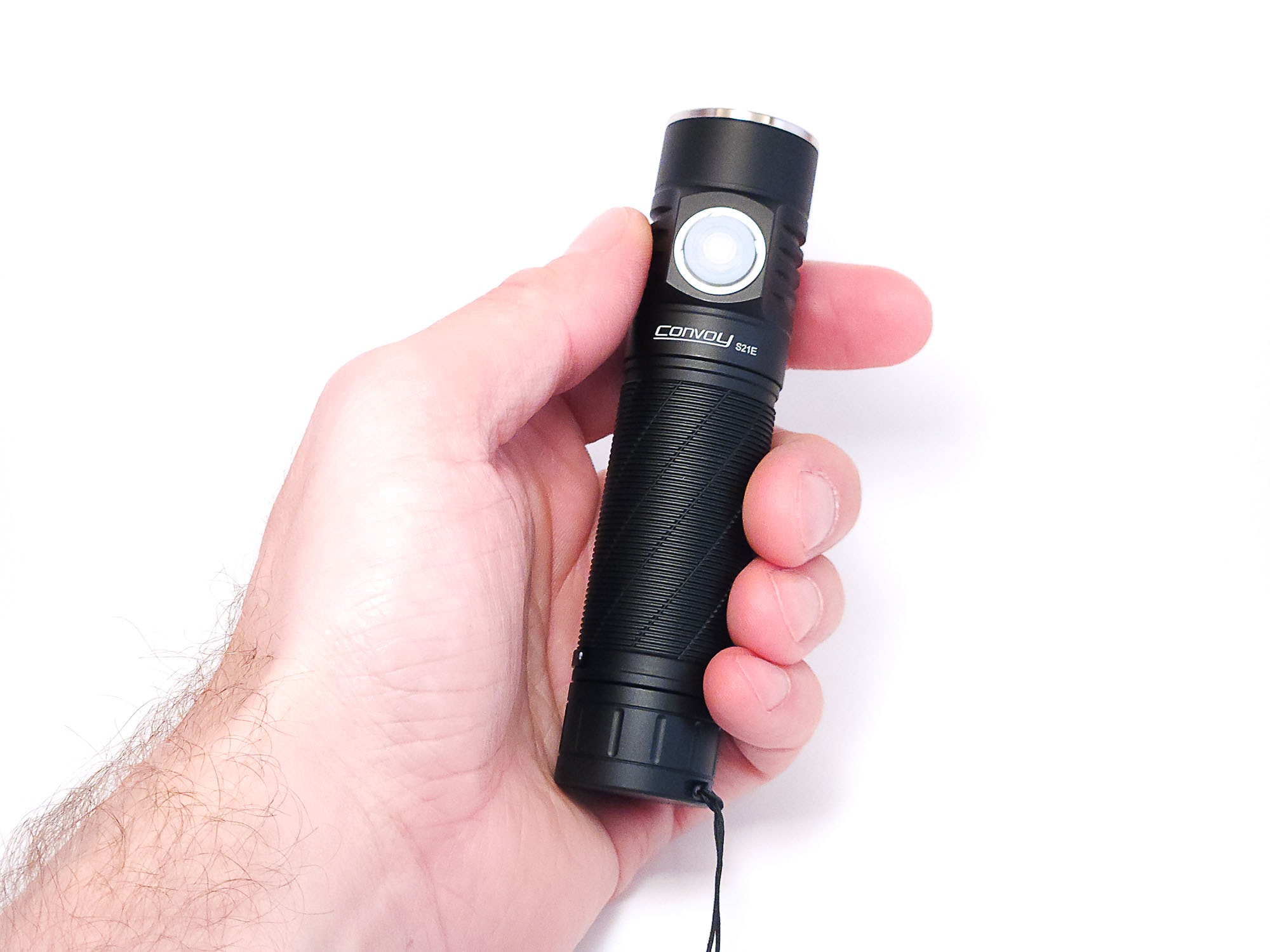
Build Quality, and Warranty
Convoy has pretty good build quality, and the S21E is no exception: The matte black anodized aluminum is uniform and free of flaws.
As mentioned above, the head has fairly large protrusions for both the button and the charging port. The white, translucent button boot is held in with a screw-in retaining ring, and the charging port has a circular rubber cover which easily lifts out and can be rotated out of the way while charging. The head also features several thick cooling fins which are otherwise flush with the rest of the head. The only branding on the light is the Convoy name and model just under the button.
The body has thin horizontal knurling with diagonal cuts through it that runs almost the length of the tube. This design is similar to the T3 and T4, and it looks pretty nice. The clip can be attached to either end of the tube and has been pretty secure so far. It does have some chips on the edges, but it’s still functionally ok.
The threads are all pretty nice. Those on the tail are anodized, so you can unscrew the tail cap for mechanical lockout, but the ones on the head are not.
At the end of the light, the tail cap has a few grooves cut in it for grip, but not enough that it could be considered knurling. They do a good enough job in helping to unscrew te tailcap. Inside, the spring is a separate piece, with a triangular base that’s captured under a retaining ring. This can easily be removed, but I don’t think there’s enough space to insert your own magnet into it.
Convoy doesn’t have a warranty, per se, but if you contact Simon (the owner) via the Convoy AliExpress store, he is very responsive and will help make things right.
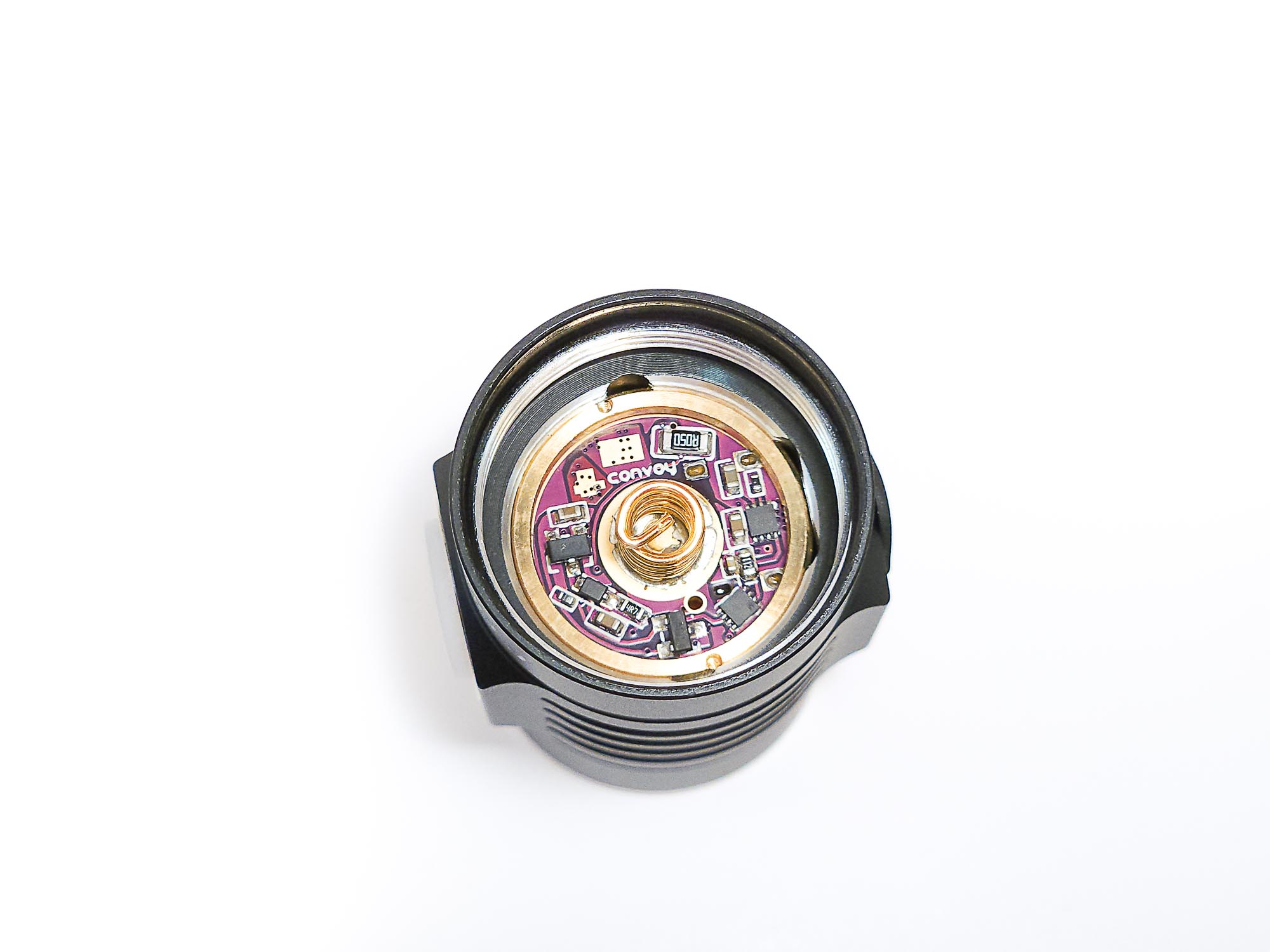
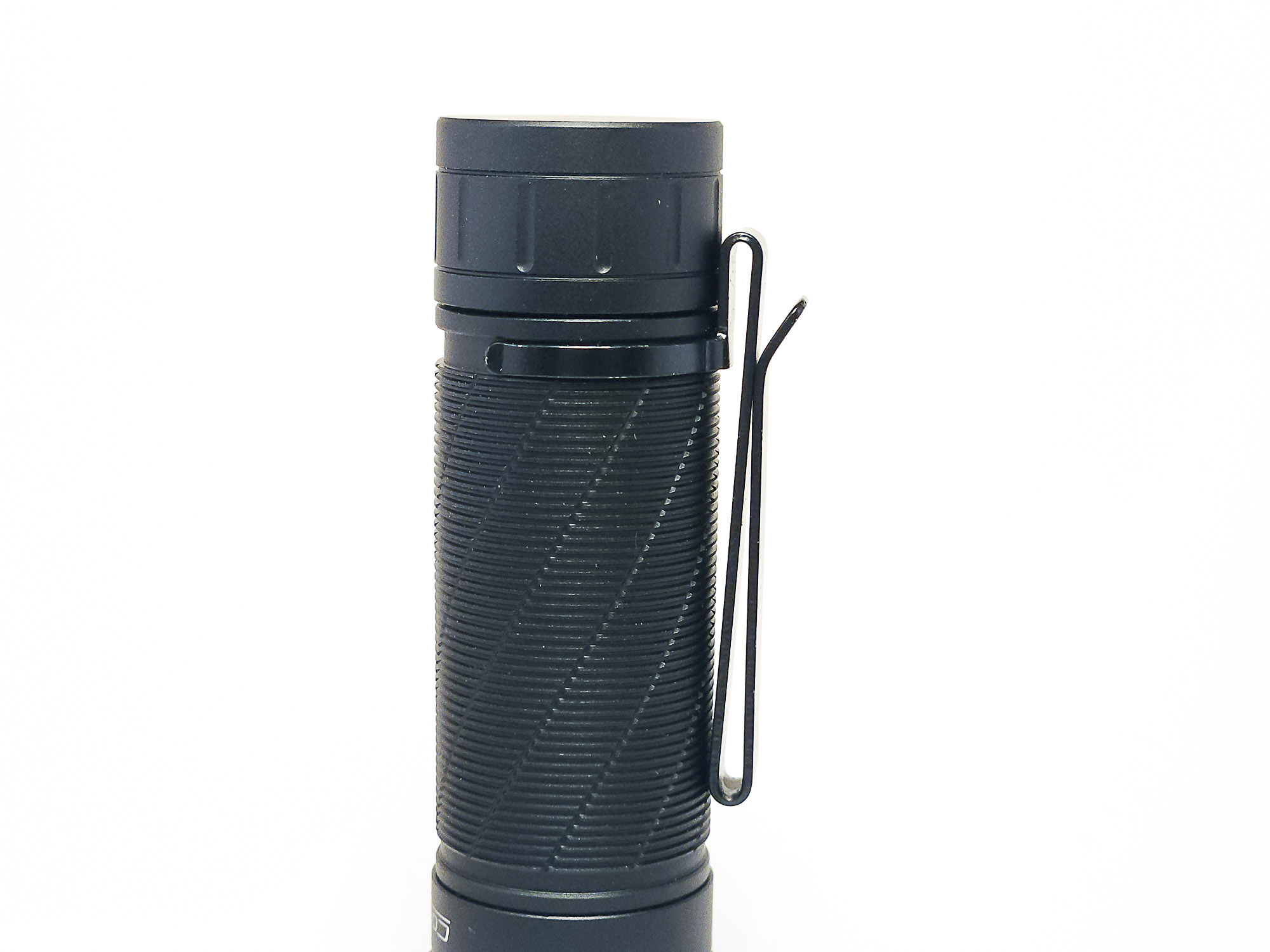



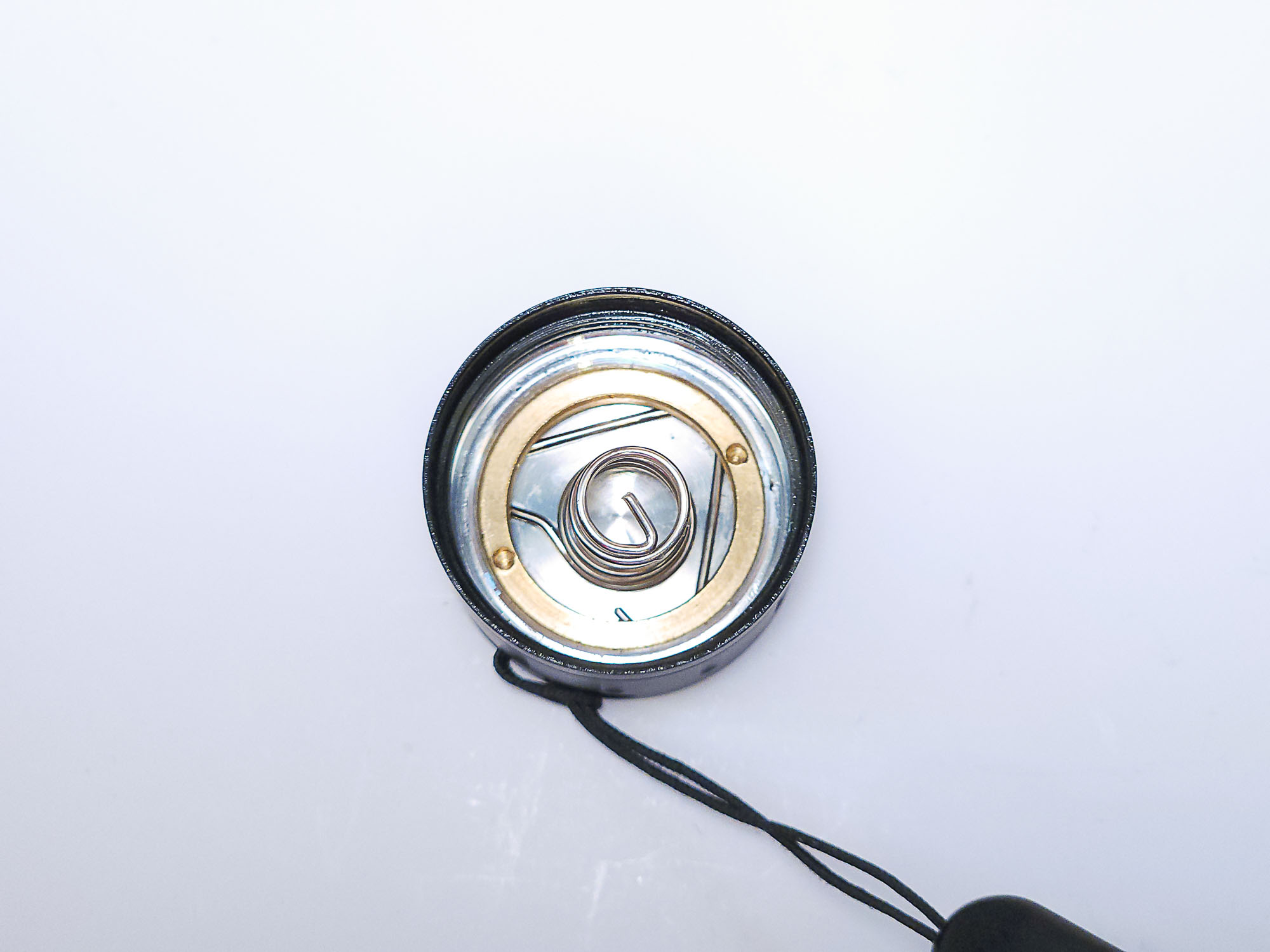


LED, Lens, Bezel, Beam, and Reflector
Like many Convoys, the S21E can be ordered with a number of emitter options. The product page on the Convoy AliExpress store lists the Nichia 519a (domed), Luminus SST40, and Luminus SFT40, and options from 2700K through 6500K, however not all CCTs will be available for every emitter. The Luminus emitters only come in 5000K and 6500K while the Nichia is available in every CCT, pending availability.
My test unit has a 3000K Nichia 519a, which is very warm and has high CRI. The beam is very nice, with the orange peel reflector smoothing out the transition from the large hotspot to the bright spill. The 3000K color temperature has a nice tint and is very usable all the way around. A higher temperature emitter will be brighter and throw farther, but often won’t have as nice of a tint, may have tint shift, and will have lower CRI.
The emitter and OP reflector are held in place with an anti-reflective lens and a smooth, screw-in steel bezel. All of this is easily disassembled which would make for easy emitter swapping.
All of my Opple measurements came in very steady in terms of CCT and Ra; the 519a produces some very nice light. Interestingly, if you look at the flicker measurements, you’ll see that there’s no PWM on this light. From 10% and up, there is some saw tooth flicker, but it’s very fast and doesn’t present a problem.
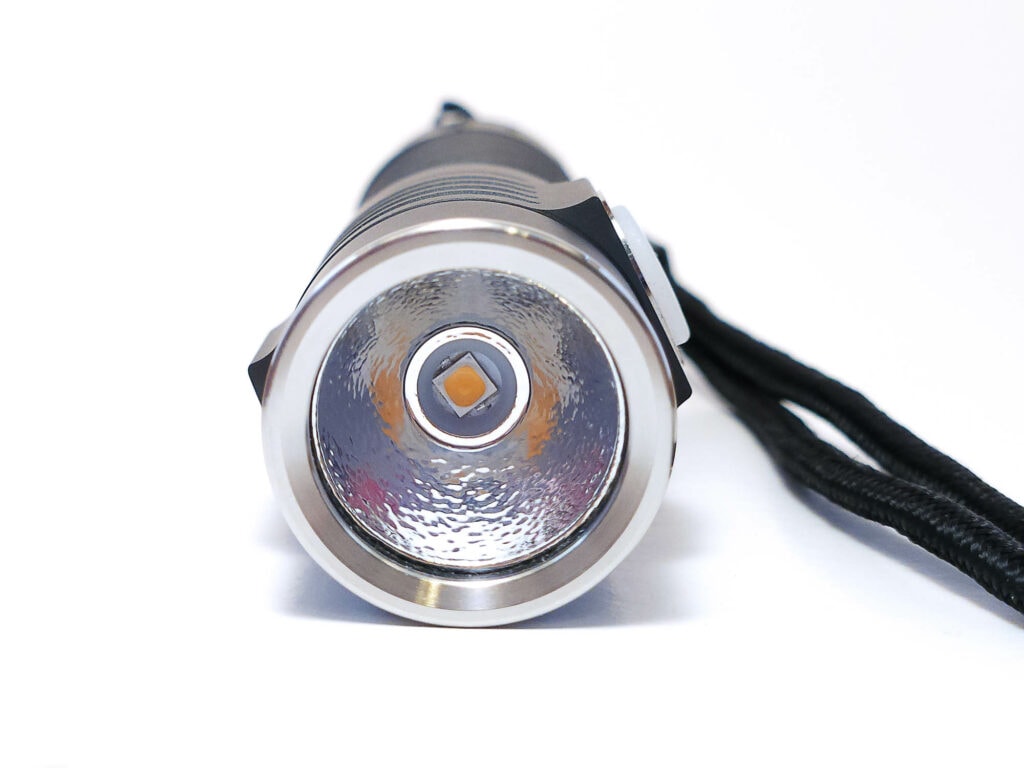
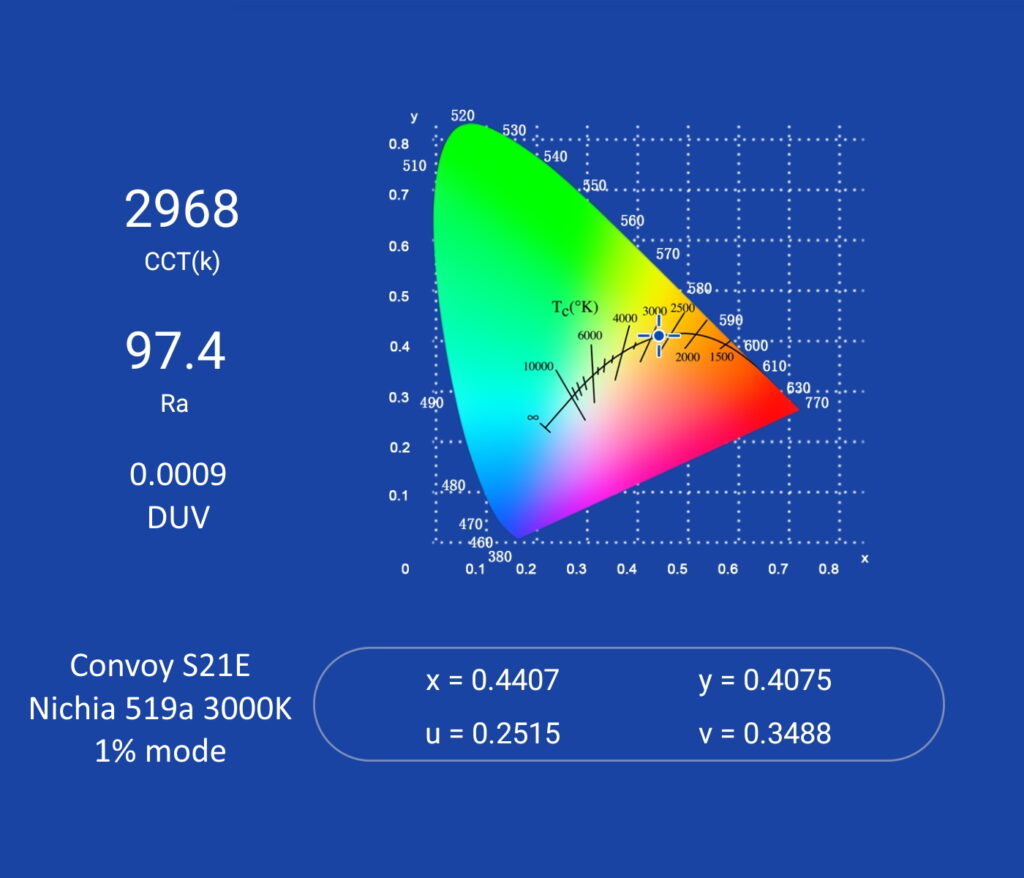
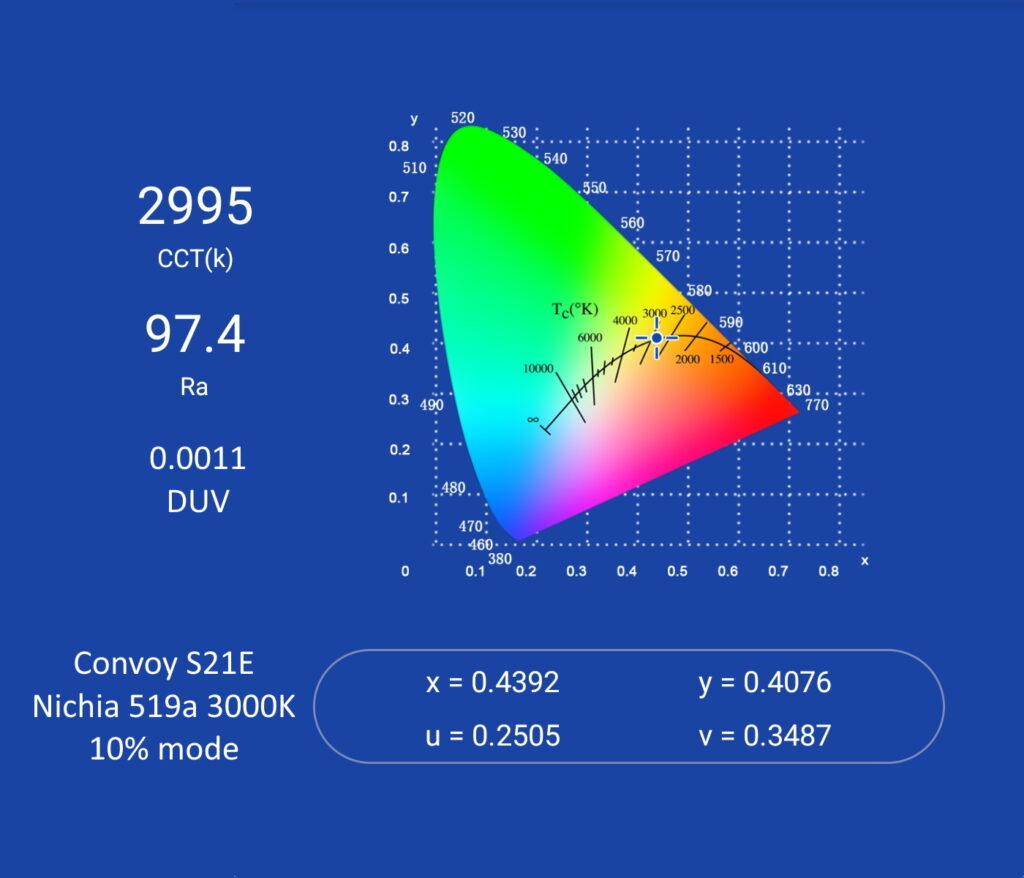
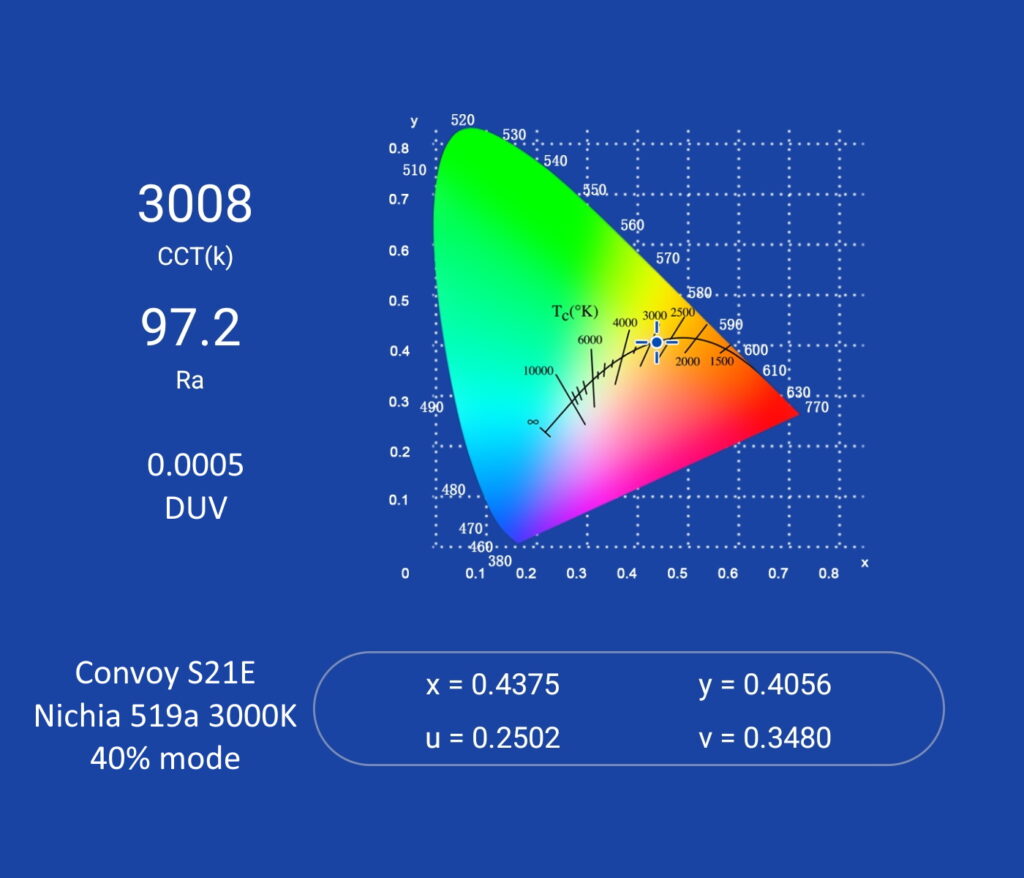
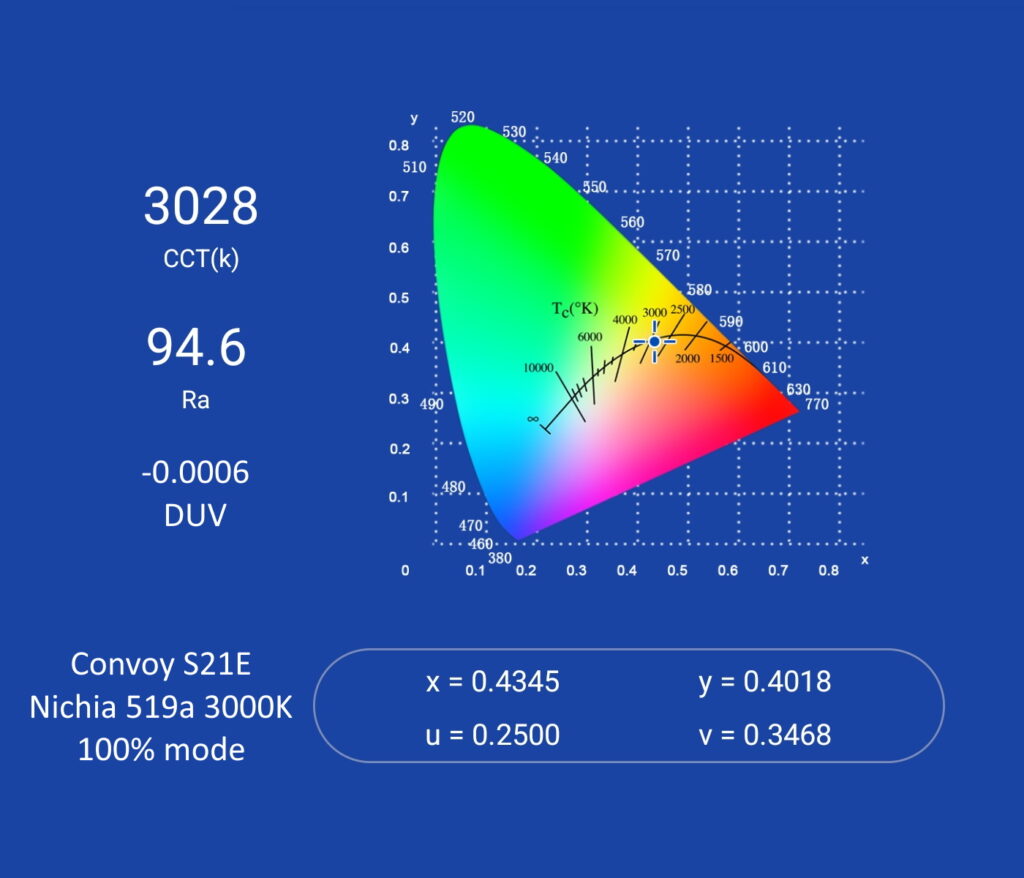
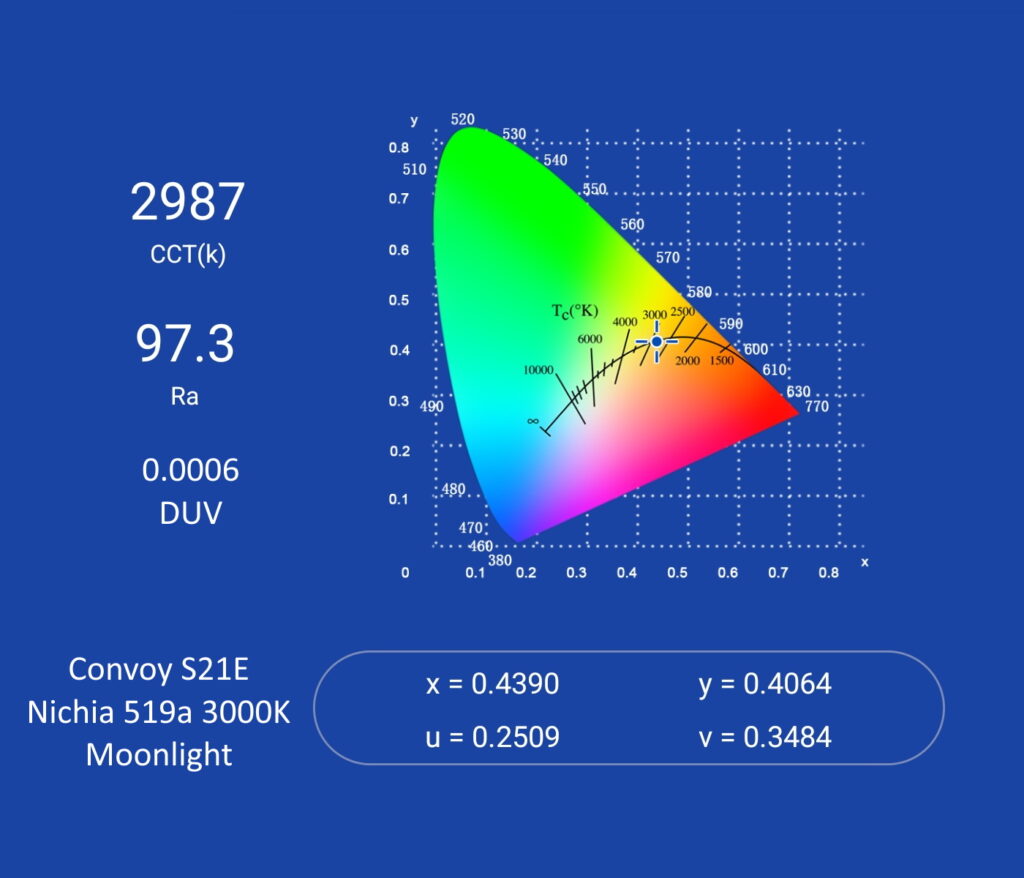

Dimensions and size comparison
Dimensions:
| Dimension | Millimeters | Inches |
|---|---|---|
| Length | 116.1 | 4.57 |
| Head diameter | 31.7 (across the button) | 1.24 |
| Body diameter | 26.5 | 1.06 |
Weight:
| Weight | Grams | Oz. |
|---|---|---|
| Without battery: | 87 | 3.07 |
| With battery | 156 | 5.5 |
Flashlight size comparison with its competition
When comparing the S21E to other lights, I was surprised at just how small this light is, for a 21700. It’s not only shorter than the Convoy S21A, the standard 21700-sized Convoy, but it’s also shorter than the Convoy S2+, which uses an 18650! These are elongated by the fact that they have tail switches.
Group 1: Convoy S21A, Convoy S21E, Convoy S2+
Group 2: ThruNite TN12 Pro, Convoy S21E, Emisar D4V2
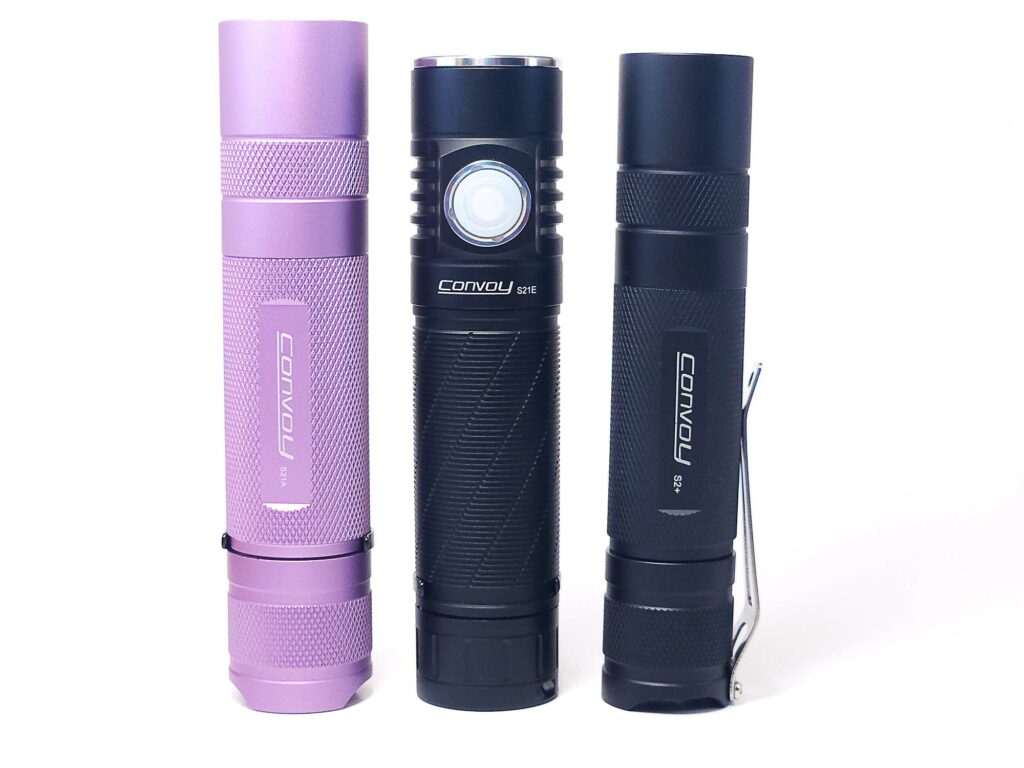
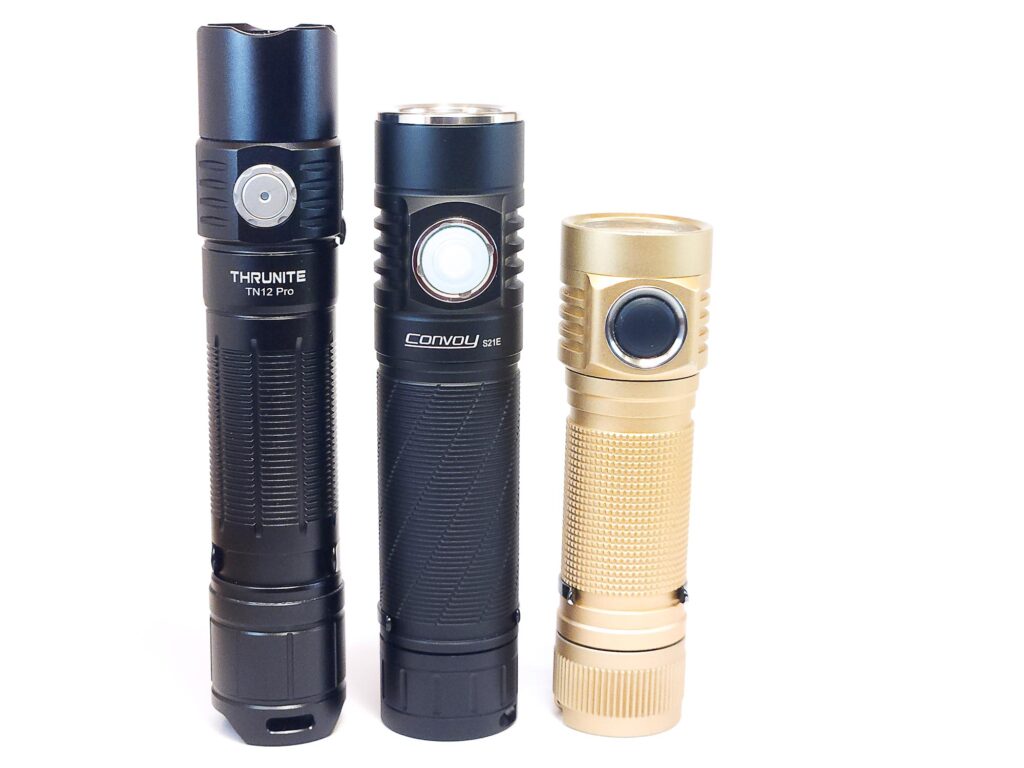
Driver & User Interface:
Available modes: Smooth or stepped ramping (4 modes), “tactical” 100% only
Available blinky modes: Strobe
User interface:
The driver for the S21E has a slightly more advanced driver than most Convoys have, with the ability to switch between smooth and stepped ramping, shortcuts for “moonlight” and turbo, as well as voltage check and lockout.
From OFF:
- Press and Hold: Moonlight
- Single click: On to memorized brightness
- Double click: Turbo
- 3 clicks: Strobe
- 4 clicks: “Tactical” mode (only momentary 100% brightness)
- 5 clicks: Voltage check
- 6 clicks: Switch between smooth ramping and 4-stepped mode
- 10 clicks: Electronic lock out
From Moonlight:
- Single Click: Off
- Hold: Nothing
- Double click: Turbo
- 3 clicks: Strobe
- 5 clicks: Voltage check
- 6 clicks: Switch between smooth ramping and 4-stepped mode
From ON:
- Press and Hold:
- Smooth Ramping: Ramp up
- Hold again: Ramp down
- Stepped Mode: Advance modes
- Smooth Ramping: Ramp up
- 1 click: Off
- Double click: Turbo
- 3 clicks: Strobe
- 5 clicks: Voltage check
- 6 clicks: Switch between smooth ramping and 4-stepped mode
Mode memory:
- The S21E will memorize brightness except for moonlight.
Shortcuts:
- To Moonlight: Hold from off
- To Turbo: Double-click from any mode except tactical
- To Strobe: Triple-click from any mode except tactical
Low voltage warning:
- The light will drop down to approximately the 1% output level and the button will blink red before shutting off around 3V.
Strobe/blinkies
- There is only one strobe, and that’s activated with a triple-click
Lock-out mode:
- Electronic lockout can be activated and deactivated with 10 clicks
- You can also unscrew the tail cap for mechanical lock out
PWM
- There is no PWM on this light.
Additional info on the UI:
- 5 clicks will take you to voltage check, where the light will blink out the voltage to one decimal place.
- Ex. 3 blinks followed by a pause then 4 blinks would mean the battery was at 3.4V
- Note that in smooth ramping mode, ramping up and ramping down always alternate, unless you’re at the top or bottom of the ramp.
Batteries & Charging
As mentioned above, the S21E has springs on both ends, so a number of batteries can fit in it. You can buy the S21E with a battery included, but my sample model didn’t come with one, so I tested with a Samsung 40T.
One of the defining features of the Convoy S21E vs other Convoy models is the inclusion of integrated USB C charging. When you plug in, there is a status light under the translucent button cover that lights up red. Then, the light takes about 2.5 hours at an advertised 2A to charge my battery from ~3V until the light turns green.
Please note that in my initial testing, reported below, I believe I had a malfunction with my testing equipment, leading to these erroneous results.
| Start voltage | Charging began | Unplugged at | Duration | Final voltage |
| 2.93V | 8:04 | 10:35 | 2h 31m | 4.29V |
| 2.98V | 9:22 | 12:13 | 2h 51m | 2.32V |
| 2.99V | 8:02 | 10:35 | 2h 35m | 4.24V |
If you know anything about lithium-ion batteries, you know that the maximum voltage should be 4.20V. In each of the three times I used the S21E to charge my battery, my multimeter read higher than 4.20V, which as the voltage increases past that, the more dangerous a situation is being created. So I thought my model had a problem. I asked Simon about this, and he indicated that this is not intended and that the charging circuitry should only bring the battery up to 4.25V at max, however, this is still higher than recommended.
I tried leaving the light plugged in a few times, and got readings of 4.37V and 4.47V, but both times when I tested a minute later, my multimeter and external charger only showed 4.21V.
So I went out and bought another multimeter (Klein Tools MM320) and tried again. Despite leaving the light plugged in for hours after the charging status light turned green, I only got readings of 4.21V on both multimeters and my external charger. I have not been able to recreate the issue from earlier.
As mentioned below, I was originally using a Cen-Tech DMM, which may very well be the cheapest one available, so in the end, I do not believe the S21E has a charging problem.
The S21E does have low voltage protection, which activated at 3V. Prior to that, the red indicator light blinks
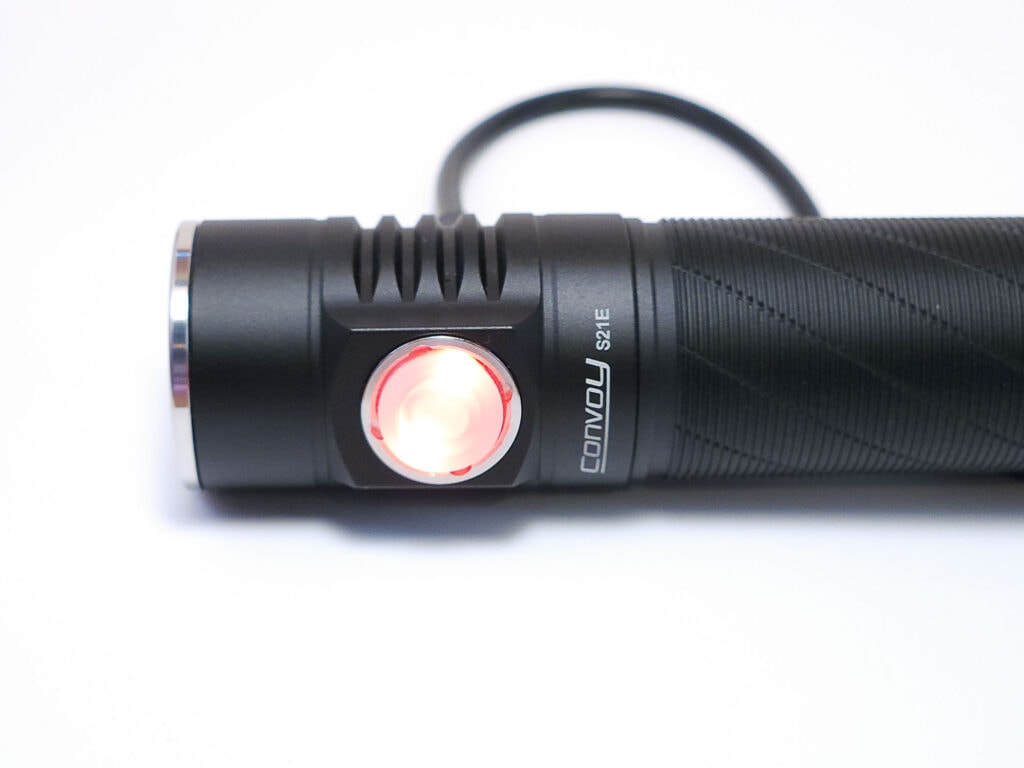
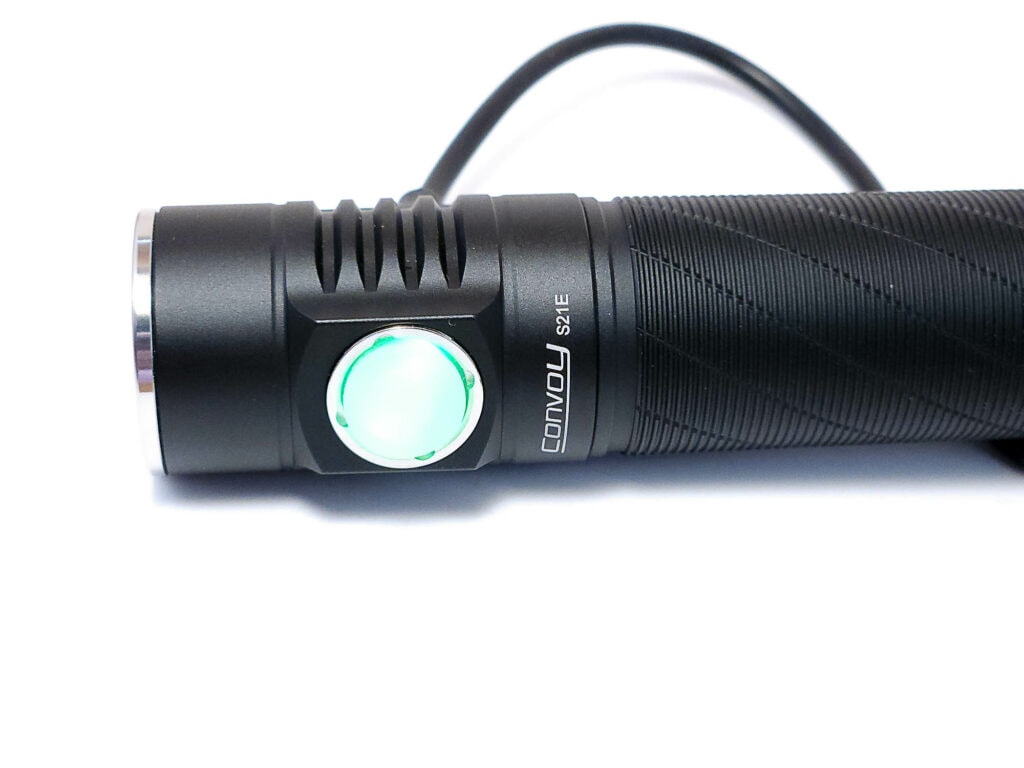
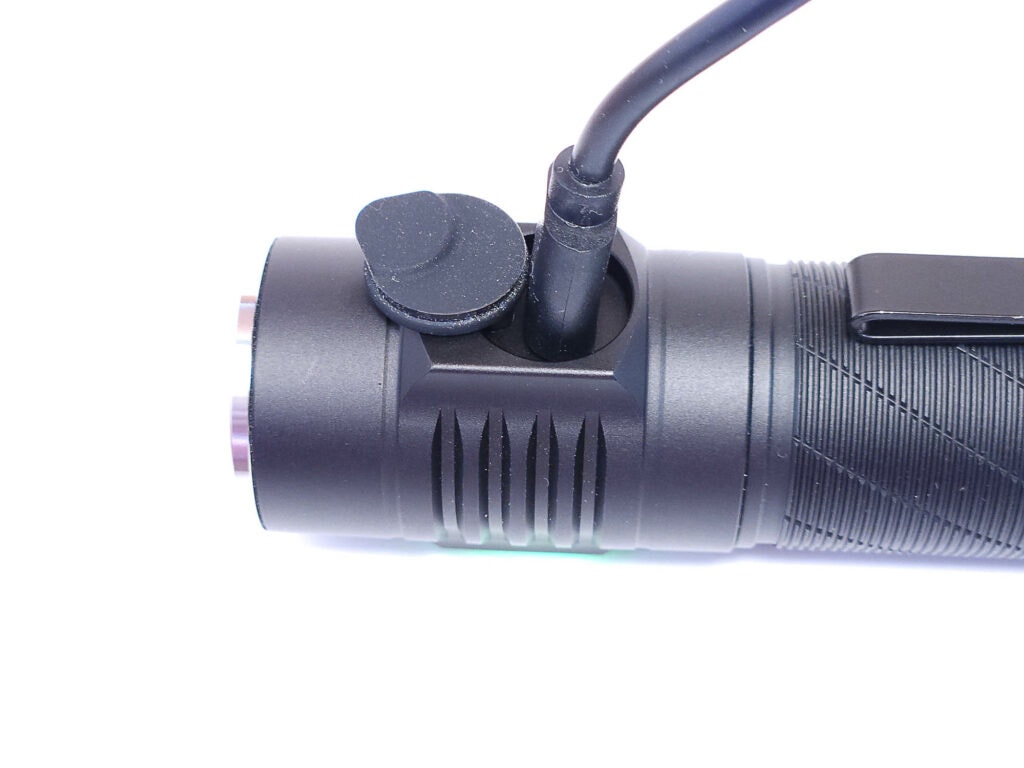
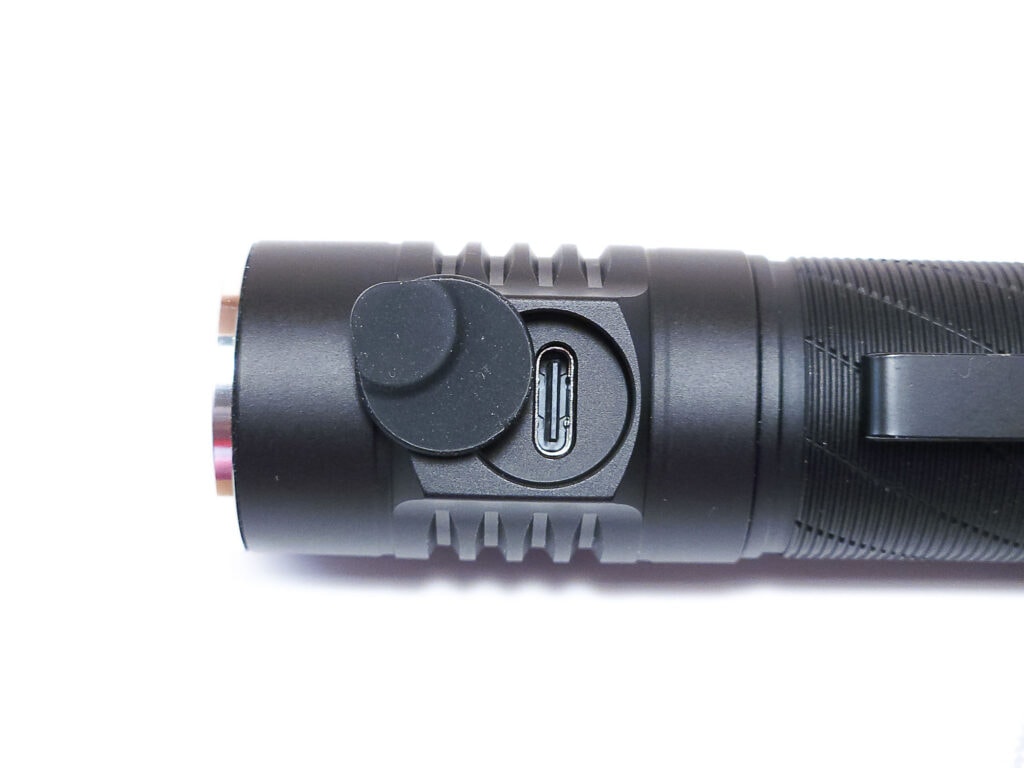
Performance test
To obtain these numbers, I used a very rudimentary integrated shoebox and ceilingbounce on my Samsung Galaxy S10. Ceilingbounce has been calibrated to match the specs of the Baton 3 as provided by Olight and corroborated with other reviewers.
For standardization, I used the 4-mode UI for testing rather than smooth ramping.
Even with the 3000K 519a, at 100% the S21E starts out at almost 1100 lumens and it gradually decreases until it levels out near the 40% mode around 480 lumens and both of those fluctuate around there for around 2 hours. The output is very flat on all of the modes aside from the turbo step down.
That regulation is very nice to see, though the experience of it might not be so nice since Convoy drivers in general are not known for superior temperature regulation. Only the 100% mode stepped down, slowly doping until it reached approximately the 40% output, then stayed there. I measured the temperature of the light while it was running with a handheld IR thermometer. During my runtime tests, with the light stationary and uncooled, I measured temperatures up to 140F/60C.
While this is definitely not desirable, nearly anyone using it would be able to feel that heat and know to discontinue use, or at least put it down. Even so, this amount of heat may be enough to damage something it’s set on top of.
One thing that could be improved is the mode spacing. 10% to 40% to 100% is ok, but having “moonlight* and 1% so close really does nothing, and 1% to 10% is a bit large. Moonlight is listed as being 0.2% power, but based on my amperage measurements, it’s perhaps more like 0.5%.
Lumen measurements
Amps were measured with a Cen-Tech digital multimeter to the best of my ability.
| Mode | Amps | Specs | Turn on | 30 sec | 10 min |
|---|---|---|---|---|---|
| Moon (0.2%) | 0.03 | – | 5 lm | 5 lm | 5 lm |
| 1% | 0.06 | – | 12 lm | 12 lm | 12 lm |
| 10% | 0.6 | – | 155 lm | 155 lm | 154 lm |
| 40% | 1.41 | – | 420 lm | 419 lm | 410 lm |
| 100% | * | 1300 lm | 969 lm | 860 lm | 424 lm |
(Edit: Nov 2022: lumen table updated with new correction factor)
Parasitic drain:
- 0 µA/mA, none measurable.
Battery Life: Runtime graphs
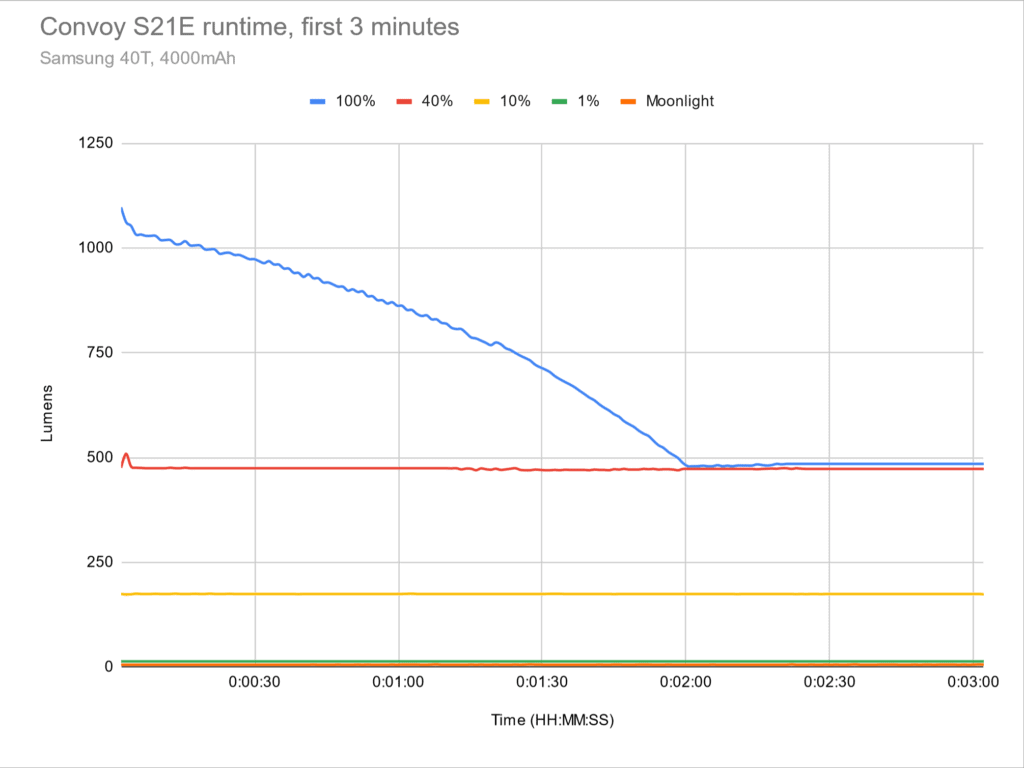
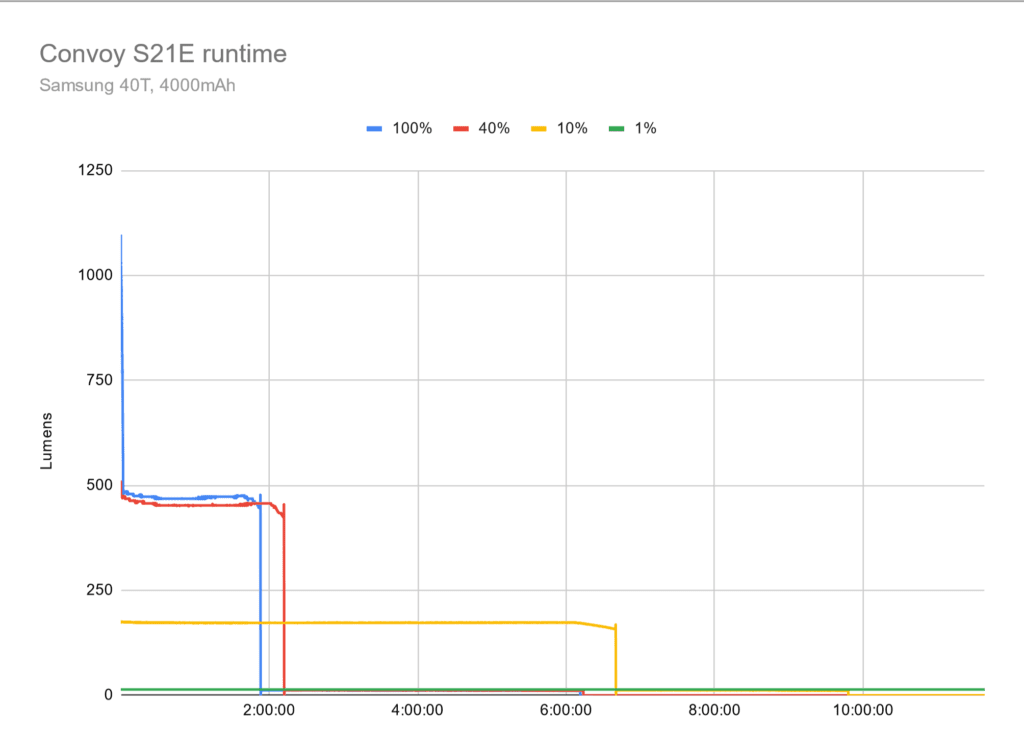
If you can handle the heat, the S21E lasts a good long time at just under 500 lumens. Between that and the lower modes, this light has good regulation! I measured 1% for 36 hours, and the battery was only down to 3.74V. By my rough calculations, 1% should last 94 hours, or almost 4 days.
| Mode | Specified runtime | Measured runtime (ANSI) | Time till shut off |
|---|---|---|---|
| Moon | – | – | – |
| 1% | – | 36h+ | 36h+ |
| 10% | – | 6h 40min | 9h 48min |
| 40% | – | 2h 12min | 6h 14min |
| 100% | – | 1h 53min | 6h 11min |
ANSI FL1 standards: The runtime is measured until the light drops to 10% of its initial output (30 seconds after turning on). This does not mean that the flashlight is not usable anymore. The last column shows how long the light actually works till it shuts off. If there is a + symbol, it means that the test was stopped at that particular point, but the light was actually still running. This happens on certain occasions, with certain drivers, firmware, or batteries.
Peak beam intensity and beam distance measurements
The numbers for candela were obtained with a UNI-T UT383S luxmeter at 5 and 15 meters, then averaged.
| Mode | Specs | Candela measured | Meters | Yards |
|---|---|---|---|---|
| 1% | – | 50 | 14 | 15.3 |
| 10% | – | 1113 | 67 | 73.3 |
| 40% | – | 3338 | 116 | 126.9 |
| 100% | – | 7650 | 175 | 191.4 |
| 100% at turn on | – | 7900 | 178 | 194.7 |
Extra info: Peak beam distance according to ANSI FL1 standards: The calculated value of distance in meters at which the flashlight produces a light intensity of 0.25 lux. (0.25 lux is about the brightness of a full moon shining on an object).
Beamshots
These were taken with a Samsung Galaxy S22+ using pro mode and the following settings:
- WB 5000K
- ISO 200
- Speed 0.5
The S21E lights up a large area. Even with the lower-powered 3000K 519a, the orange peel reflector makes for some very usable spill. The hotspot’s nothing to laugh at, either. It makes me wonder just how much brighter it would be with the SST40 or SFT40.
Beamshots compared to the following flashlights:
- Convoy S21A with Nichia B35AM
- Concoy S21E
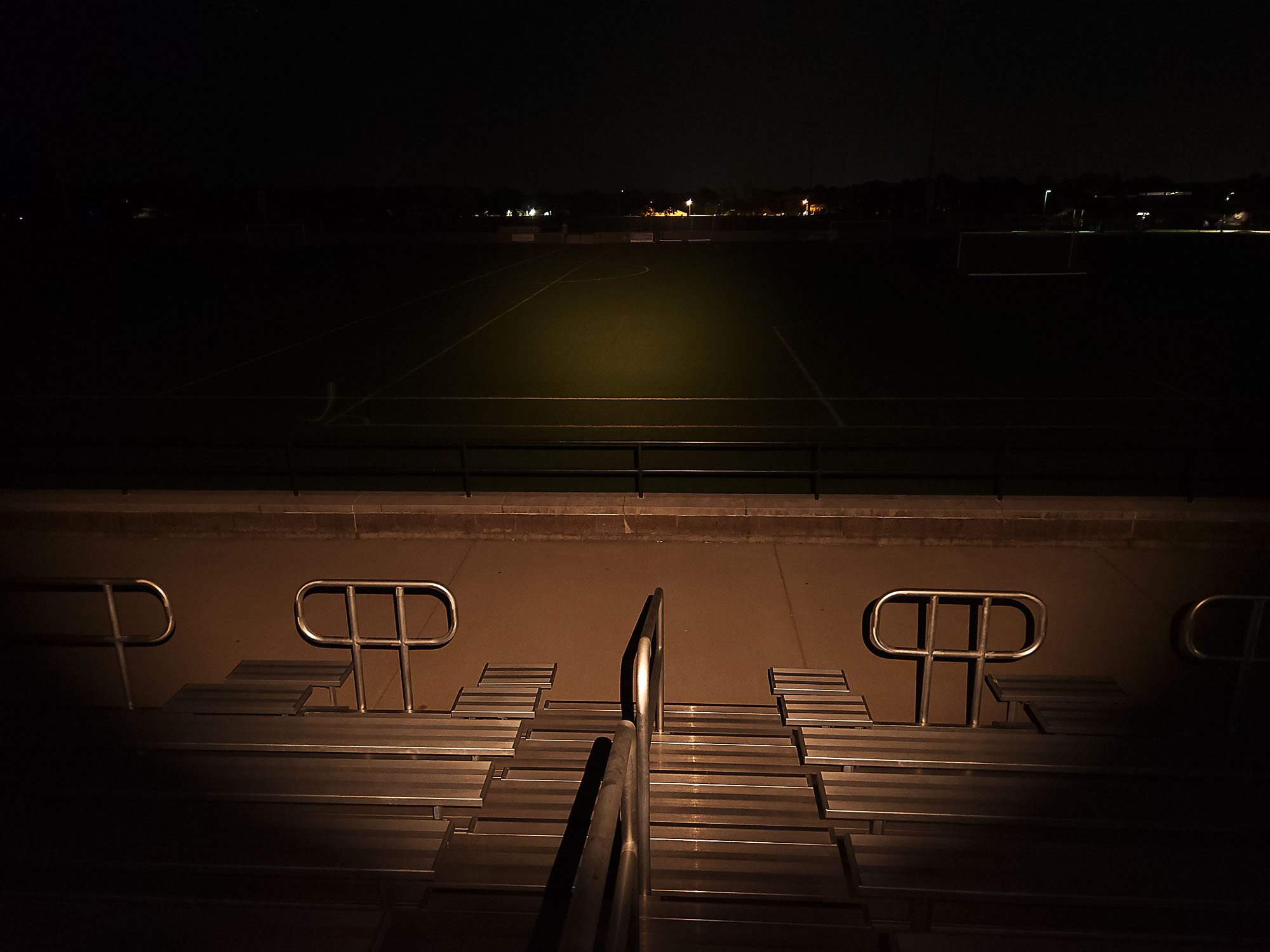
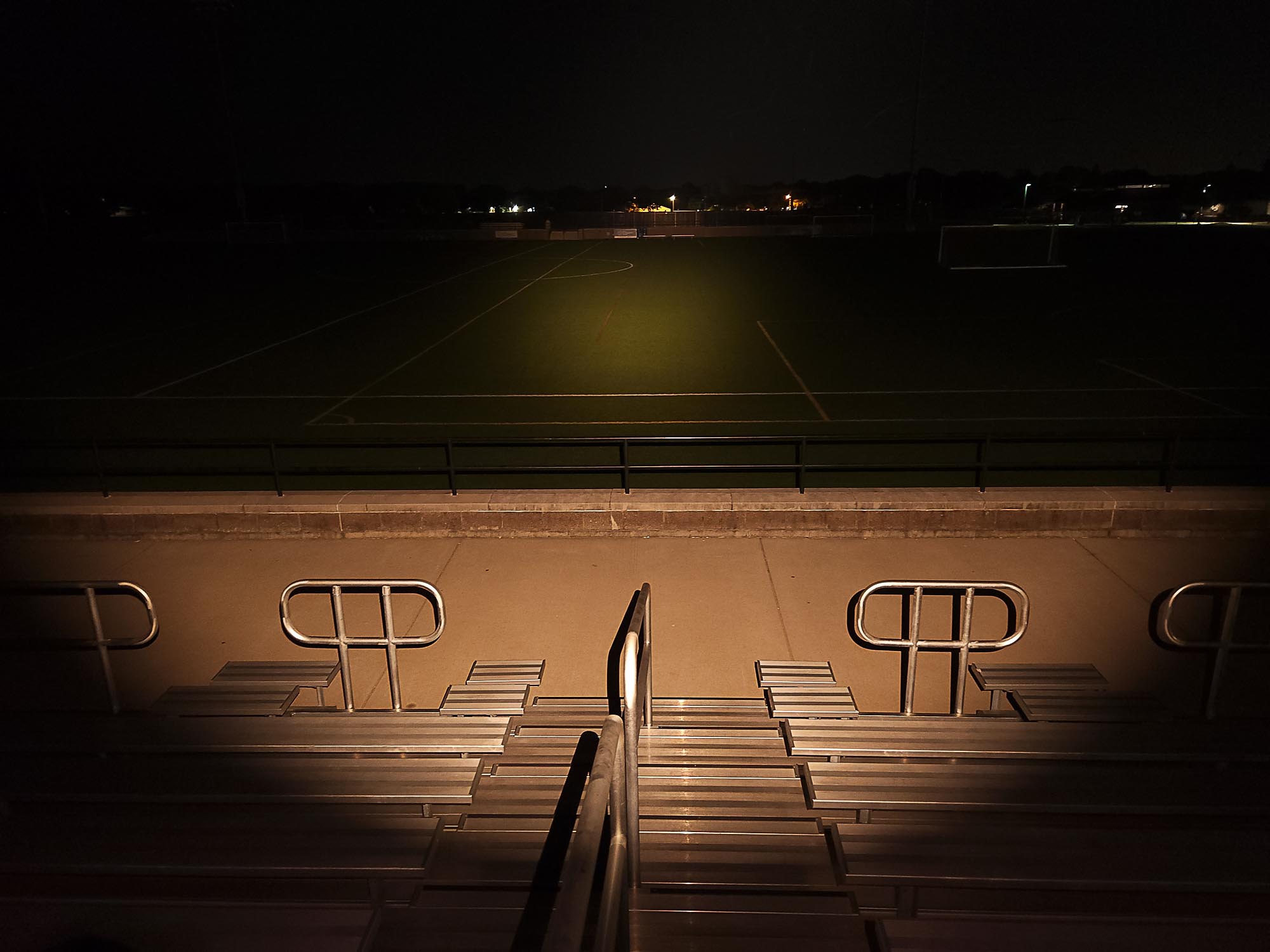

Disclaimer: This flashlight was sent to me for review at no cost by Nealsgadgets. I have not been paid to review, nor have I been holding back on problems or defects.
Final Verdict
Pros
- E-switch Convoy
- USB C charging
- Small for a 21700
- Smooth and stepped modes
- Convoy modding potential
- Can be purchased with a battery
Cons
- Poor thermal management
- Modes could be more evenly spaced out
- Only IPX4
- S21 clip too tight to fit over jeans pocket
Explanation on star ratings:
1: Avoid: a match would be a better choice – 2: Poor: significant defect or issues; almost unusable – 3: Average: some defects or issues; but still usable 4: Good: recommended (minor issues) – 5: Great: highly recommended

4 stars: ★★★★
The S21E has a lot of good points, like USB C charging, emitter options including the 519a, regulation, size, and a simple yet customizable interface. Heat is an issue, but if you reach for or grab a light that’s extremely hot, your human reflexes will probably cause you to pull away from it quickly.
If you’re looking for a general purpose 21700 light that can be had as an (almost) full package, keep this one in mind.
Convoy S21E for sale & discount code
Use our unique 1Lumen discount code at Nealsgadgets: 1LumenNew or 1Lumen711
1lumen selects and reviews products personally. We may earn affiliate commissions through our links, which help support our testing.